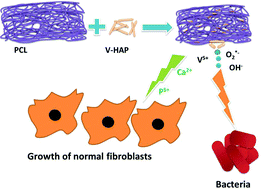Polycaprolactone-based antibacterial nanofibrous scaffolds containing vanadium/hydroxyapatite and their morphology, mechanical properties, and in vitro studies
Abstract
Repairing the damaged wound tissues is a vital requirement for keeping an adequate clinical care system. In this work, nanofibrous scaffolds of polycaprolactone (PCL) were encapsulated with hydroxyapatite (HAP) doped with different concentrations of vanadate ions. The contribution of (V) ions causes a decrease in the volume of the unit cell from 536.94 (1.6) to 535.22 (1.63) Å3. The powder phase of vanadate/hydroxyapatite (V–HAP) was formed with the grain size in a decreasing pattern from 2 μm at 0.0V–HAP, reaching 1.1 μm at 0.8V–HAP. Moreover, the maximum roughness peak height starts at 523.2 nm in the vanadate-free composition, reaching 678.9 nm with the highest vanadate contribution. Furthermore, the average roughness enlarged from 106.1 to 167.3 nm, while the nanofiber phase showed an increase from 94.2 to 237.9 nm. Additionally, the V–HAP@PCL scaffolds were configured as networked fibers with diameters ranging from 1.2 μm, 1.2 μm, 1.1 μm, 0.6 μm, 0.6 μm, and 0.9 μm, respectively for the different additives of vanadium. Moreover, the antibacterial activity was examined and it was shown that the inhibition zone increased from zero mm at 0.0V–HAP@PCL to around 6.5 ± 0.7 and 8.1 ± 0.4 mm for 1.0V–HAP@PCL against E. coli and S. aureus with the highest vanadate addition, respectively.



 Please wait while we load your content...
Please wait while we load your content...